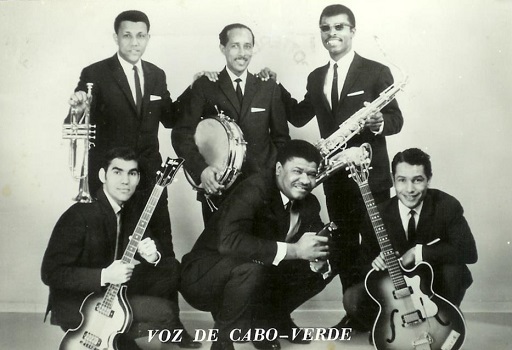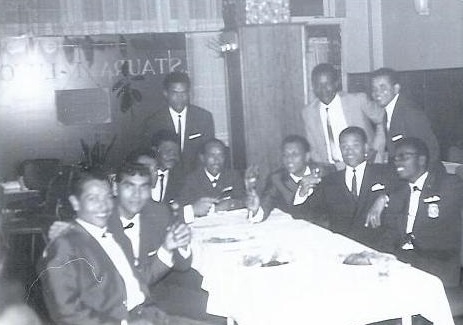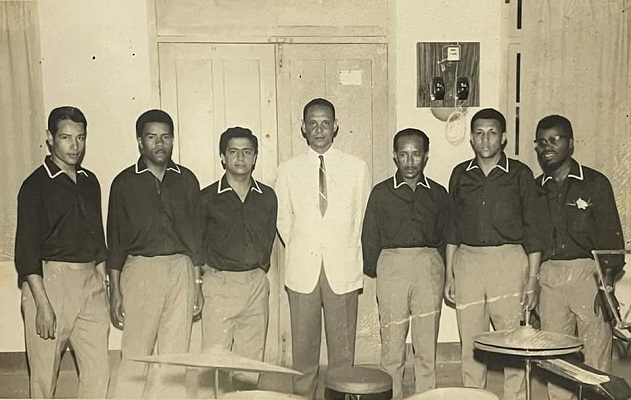Voz de Cabo Verde (I)

Group, 1965-1970
Voz de Cabo Verde became famous in the 1960s and continued to evolve for the next 30 years. Based on electric instruments, its initial members included Luís Morais (clarinet, saxofone, and flute), Morgadinho (trumpet), Toy d’Bibia (guitar), Jean da Lomba (bass) and Frank Cavaquinho (drums).
Frank, who had already been in the Netherlands since 1964 and worked at the Heineken brewery, called the others, who were working in Dakar, and were already music professionals performing in nightclubs. For example, Saloum, whose owner, according to Morgadinho informed to Cabo Verde & a Música – Museu Virtual, was named Nuna and was from Santiago. “He was a merchant, owner of comercial houses in Dakar, and as a music enthusiast, he had that venue built. We were [the musicians in the photo below] the musical group thet debuted the venue”, revealed Morgadinho. Bana was also in the capital of Senegal, where he launched his first EP with Pathé Marconi. After arriving in Rotterdam, they initially work in a factory, acquired equipment, and began playing.

In his memoir, De Ribeira Bote a Rotterdam, Djunga de Biluca, who produced and edited the group’s albums, states that initially “they were not yet thinking about forming an orchestra, just about playing at Creole parties”. The group’s first recordings, at that time appearing under the hastily arranged name – Os Verdianos, were for Bana’s first LP, Nha terra. In subsequent recordings, the same formation is credited as Voz de Cabo Verde. They accompanied Bana on his second LP, Pensamento e segredo (1966), and on Bana a Paris (1966), the latter released by Bana himself after his departure from the group.
Bana’s departure, according to members of the group and Djunga de Biluca, (Cabo Verde & a Música Dicionário de Personagens), was due to a contract with the cabaret La Bonanza, whose owner required a more versatile singer who could perform the popular rythms of the time. Bana only sang mornas and koladeras. “So, we were left without a singer, and I had to step in”, recalls Morgadinho: “I learned English, I already spoke a little French, and I learned to play bass so that we could fill in the gaps, as we didn’t have an organist either. Jean da Lomba played rhythm guitar, Toy playes lead guitar, and I played bass and sang. When a trumpet was needed, I passed the bass to Jean da Lomba, Toy provided accompaniment, and I took care of the wind instruments”.

This phase did not last long, until Djosinha entered the scene, leaving his job as a seafarer to stay in Rotterdam from 1967 onwards as the group’s lead singer. Regarding the organizational structure of Voz de Cabo Verde, Djunga de Biluca clarifies that Luís Morais was the leader, and, as such, he was responsible for the group at the time of contracts (A Semana, 03.04.2005).
The importance that Voz de Cabo Verde gained hawas closely tied to its impact on the self-esteem of Cape Verdeans. “There were many Cape Verdeans in the Netherlands working in the merchant navy, and since Cape Verdeans really love music, they went out to listen to good bands. At the time, Italian ensembles predominated in that part of Europe (Netherlands, Germany, Belgium, Scandinavian countries)”, says Morgadinho. “So, they felt great pride knowing that a group from Cape Verde was emerging to showcase our talent”.
Voz de Cabo Verde’s discography during its first phase consists of seven LPs and four EPs, recorded between 1965 and 1969 but released until 1972. The collection features a mix of Cape Verdean songs – many written by Luís Morais, some in collaboration with Djunga de Biluca, and others by Morgadinho and various authors – alongside foreign ones, particularly Latin American genres (boleros, cumbias and other genres) and Brazilian styles (sambas, choros, sambas-canção). Occasionally, popular American songs from that era also make na appearance. The last album, Bonita, features all titles in Spanish, foreshadowing an upcoming album entirely devoted to cumbias and other rhythms from the Latin American musical universe. However, the autorship of most of the songs in these styles belongs to Luís Morais rather than foreign songwriters.

The eclectic and international repertoire of Voz de Cabo Verde is explained by Morgadinho in an interview during their first tour to Cape Verde: “Recordings of music from our land are intended for a relatively small audience (…) as professionals, we cannot overlook the comercial side of our situation, so let’s focus on international music recordings, like the LP Dançando com a Voz de Cabo Verde”. When asked whether this approach woul incur costs in terms of copyright, he replied that there were already enough of his compositions, along with those of Luís Morais and Frank Cavaquinho for a new LP. These works, “being original, do not fail to align with the prevailing tastes in the main European centers concerning music for entertainment and dancing” (O Arquipélago, 01.04.1968).
In December 1967, the group was in Lisbon with no concrete prospects for the future, as reported by Luís Morais in an interview with O Arquipélago (12.28.1967). However, on January 2, 1968, the six musicians disenbarked in São Vicente. The newspaper detailed detail their arrival: “Early morning, and the entire píer was a sea of people welcoming family members who had come from outside the province. Among them were the members of the famous group Voz de Cabo Verde (…) who disembarked and were embraced by hundreds of people” (O Arquipélago, 01.04.1968).
There were interviews and news about the performances that dazzled the Mindelense public: “Their first show exceeded everyone’s expectations. It eas a complete success. With varied instruments creating luminous sparks (which cost close to two hundred contos); and the impeccable presence of its members; Eden Park was overflowing with people from all walks of life; the ensemble presented 28 international-class numbers …” (O Arquipélago, 01.11.1968). “The success of Voz de Cabo Verde ensemble continues in an extraordinary way. Tickets consistently sell out several days in advance, with the number of shows already reaching five, including tonight’s performance. According to wone of those responsible for the ensemble, another show will be given– the last – probably at Clube Mindelo, to allow the general public, especially those economically less privileged, to attend” (O Arquipélago, 01.18.1968).
That year, the carnival ball at Parque Miramar was animated by the group, as reported by the same newspaper (2.29.1968). Before that, they took a trip to Praia, where they spent an intense week performing at the Cine-Teatro Municipal during various parties organized in honor of the President of the Republic and at the dance organized by Rádio Clube de Cabo Verde (02.14.1968). However, the apotheosis was yet to come: as a farewall after a month and a half in Cape Verde, the group decided to offer the Mindelense population na open-air concert, in the square’s bandstand.
“From the neighboring neighborhoods, an enthusiastic and frenzied crowd positively ‘assaulted’ the city center, marching in compact columns towards praça Serpa Pinto [Praça Nova]”.
O Arquipélago, 03.14.1968, about the last Voz de Cabo Verde concert in Mindelo.
Even from distant places like Mato Inglês and Salamansa, people came and, for around two hours, listened “excitedly” to the music of the boys from Holland. They left with plans to return the following year, albeit with a change in the lineup: Jean da Lomba, who had decided to emigrate to the USA, was replaced by Chico Serra, who would then play bass and keys.
Throughout that year, Voz de Cabo Verde fulfilled contracts in the Netherlands, performed in Paris for the Portuguese Community, and visited Portugal, where they played in Coimbra for students. In December, their return was announced in what O Arquipélago (12.05.1968) called the “II Tournée de Saudade”. In addition to performances in Mindelo and Praia, the group traveled to Bissay to entertain at the end-of-year festivities for the União Desportiva Internacional de Bissau (UDIB).
It was in the midst of a liberation struggle. In this regard, Djunga de Biluca – at the time a key player in Europe in the ongoing liberation struggle in the forests of Guinea – writes in his memoirs that he found it prudent to contact Amílcar Cabral to gauge the leader’s thoughts on this trip. “Cabral was very happy with the formation of this orchestra that symbolized and represented Cabo Verde”, he writes. He believed they should proceed, but with caution, as the Portuguese might seekto exploit any incidentes for political propaganda. However, it appears that the group only performed in Bissau, specifically at the elite club that was (União Desportiva Internacional de Bissau (UDIB).
However, in 1968 something importante remained undone: “We were invited by Bruno Coquatrix [owner of the famous Parisian concert hall Olympis da célebre sala de concertos parisiense Olympia] to do 15 days of performances. Unfortunately, we didn’t sign the contract, we didn’t feel safe, we were afraid we wouldn’t be up to playing at the Olympia yet. It was supposed to be from the 5th to the 20th of May 1968”, explains Morgadinho (Cabo Verde & a Música Dicionário de Personagens).

In January 1969, back in Cape Verde, they played at the ball celebrating the first anniversary of the Hotel Porto Grande (O Arquipélago, 01.16.1969). During carnival, they split their performances between Praia (where Pousada Praia Mar also hosted Duo Ouro Negro, from Angola) and São Vicente. At the end of February, they traveled to Fogo and Brava. The tour received “high sponsorship from the governor of Cape Verde, Commander Sacramento Monteiro and was organized by the Information and Tourism Center”, notes O Arquipélago, adding: “They were set to continue beyond Fogo and Brava, heading to Sal and São Nicolau. Other islands were not included due to the lack of electrical energy, which is essential for the group’s operations” (O Arquipélago, 01.20.1969). In Santiago, in addition to Praia, they performed in Santa Catarina and Tarrafal, engaging in dances and shows.
Throughout this period, there was na abundance of news about the group and its members, including information about Luís Morais’ wedding, on 12.28.1968 (O Arquipélago, 09.01.1969). The tour in Cape Verde concluded on March 8th (O Arquipélago, 3.13.1969), after which they left for Guinea, as noted in the April 24, 1969 edition of the newspaper (the only one in Cape Verde at the time). On November 27, 1969 the newspaper announced the group’s presence at the year-end festivities and the 1970 carnival, but the planned trip in December ultimately did not happen. However, they arrived in time to participate in Carnival, among other performances, although Toy Ramos was provisionally replaced by Baptista Dias, amid rumors that the group was on the verge of breaking up.
The same edition of O Arquipélago reports this information on page 2, expressing regret about the situation (01.29.1970). On page 4, there is advertising for performances in Praia, while page 5 includes an article stating that the rumors of dissolution are merely gossip. However, the following edition (02.05.1970) referes to the end of Voz de Cabo Verde, urging it – described as an “ambassador of Cape Verdean artistic intuition”, not to disband.
In March 1970, after a new trip to Guinea (there were three in total), Voz de Cabo Verde spent around two months in São Vicente before continuing to Angola and Mozambique (O Arquipélago, 05.21.1970). At the end of 1970, they returned to São Vicente and, alongside Os Caites, performed at a party to benefit hospital patients (O Arquipélago, 12.17.1970). During this time, Djosinha, Chico Serra and Morgadinho also left the group.
“A team is almost like a good horse: it runs well, but if it doesn’t have a jockey, it runs anyway; there was no manager, no one to manage things, no discipline – the group didn’t belong to anyone. It became fragile; no one had a commitment to anyone”.
Morgadinho, in Cabo Verde & a Música Dicionário de Personagens, on the reasons for the disintegration of Voz de Cabo Verde.
About a year later, an article in the same newspaper discusses a Cape Verdean night in Bissau featuring Voz de Cabo Verde and Djosinha (O Arquipélago, 11.25.1971). Subsequently news reports noted the group accompanying Bana at a carnival ball in São Vicente and at the closing of the Miss Cabo Verde contest in Praia (O Arquipélago, 02.17.1972). “Registering a house with a wedge” [the Cine-Teatro in Praia], “in addition to the warm sentimental coladeiras in the unmistakable voice of Bana, Jorge Sousa and Tony Óscar provided the audience with an expressive repertoire of South American folklore and of pop music, while Luís Morais showcased his virtuosity in the exquisite solos on his golden saxophone” (O Arquipélago, 02.21.1972). A new phase had begun.
In 2014 a photobiography of the group was released, titled Voz de Cabo Verde – A História de um Povo, by David Santos and Vanessa Sousa.
Discography
- Agora e abol, EP, MR, Rotterdam, [1960s]. Soloists: Djosinha, Morgadinho.
- Nova coladera, EP, MR, Rotterdam, [1960s]. Soloists: Djosinha, Morgadinho.
- Ragoce d’manhe, EP, MR, Rotterdam, [1960s]. Soloists: Djosinha, Morgadinho, Luís Morais.
- Voz de Cabo Verde, EP, MR, Rotterdam, [1960s]. Soloists: Morgadinho and Luís Morais.
- Dançando com a Voz de Cabo Verde, LP, MR, Rotterdam, 1967.
- Regresso de Voz de Cabo Verde, LP, MR, Rotterdam, 1968. Solista: Djosinha.
- Instrumental, LP, MR, Rotterdam, 1969.
- Mechê, LP, MR, Rotterdam, 1969.
- Partida, LP, MR, Rotterdam, 1969. Soloist: Djosinha.
- Ilha do Fogo, LP, MR, Rotterdam, 1971. Soloist: Djosinha.
- Bonita, LP, MR, Rotterdam, 1972. Soloist: Djosinha.











Listen to
Thanks to Francisco V. Sequeira and Morgadinho for supporting the creation of this page.